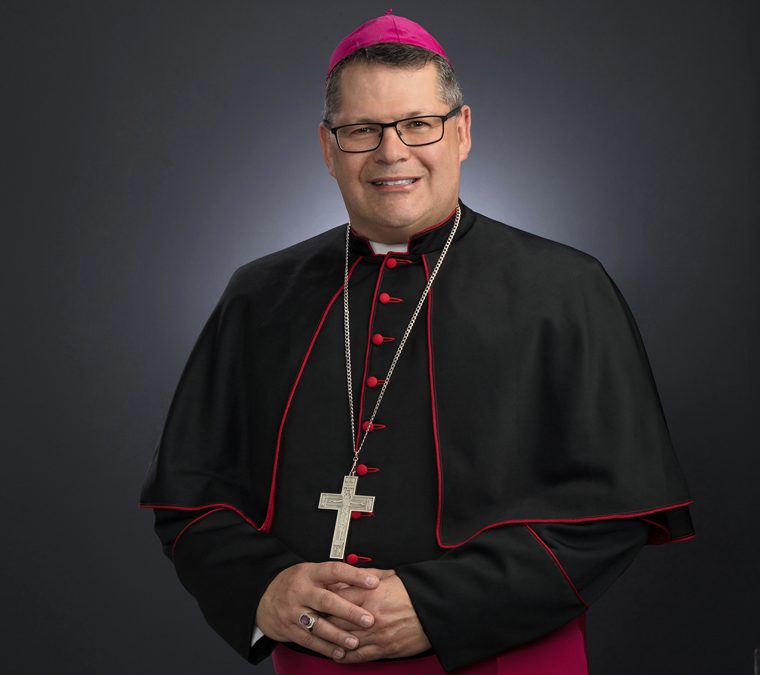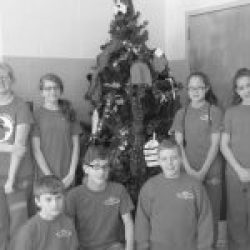Following is the homily that Bishop Douglas J. Lucia preached at the Sept. 19 Centennial Mass at Blessed Sacrament Church in Syracuse.
It is indeed a pleasure to be with you all this afternoon as together we offer this Mass of thanksgiving. As we reflect today on the Word of God we have three interesting images: (1) We have the image of the temple from which flows water, water that comes to refresh God’s creation. Not only does it refresh God’s creation, but it comes to heal God’s creation. (2) Then we hear again of the temple in our second reading—a temple in which we are called to be the temple of God. In fact, St. Paul writes, “Do you not know that you are the temple of God, and that the Spirit of God dwells in you?” (1 Cor 3:16). (3) And then in our Gospel reading today, we, of course, see the money changers being driven from that temple. We see Jesus asking that question, “What have you done to my house?” Making it a den of thieves instead of a house of prayer. In fact, it is in this scene that one finds not only an allusion to Jesus’ own death and resurrection, but also his prediction of the destruction of the temple in 70 AD. It is also important to note that he promises that the temple will be rebuilt. Now, you and I might be wondering how does this temple get rebuilt and what is one’s involvement in it? Isn’t that always the question?
I can only imagine 100 years ago what the folks here in Eastwood were thinking. I can imagine they were wondering, how are we going to build this church? How is it going to be erected? And although they would eventually use beautiful stones, we realize that these stones are only representative of something greater and that is the living stone (see 1 Pt 2:4-5). The living stone that you and I are called to be in building up the Body of Christ today. And if we consider what Christ’s mission was … Christ’s whole mission that was summarized in the movie Passion of the Christ in that moment when Jesus meets his mother Mary in the film and he says, “See I have made all things new!”
How do you and I today bring this newness to this temple? How do you and I today bring this newness to Eastwood? How do we bring newness to the Church? Isn’t it by you and me claiming who we are? We are the building blocks upon which the Church is built. So, it is our own confession of faith, our own profession of faith—where it is not only to say that “I believe,” and that in the word “believe” is always the word “live.” And you and I are called to let God’s word, to let God’s presence be found in us and through us. Think of the words that we say at the end of the Eucharistic Prayer: “Through Him, with Him, and in Him” or as people heard, when I did it in Italian today: “Through Christ, with Christ and in Christ.” And for you and me, sisters and brothers, that is the challenge the word of God gives to us, today.
You and I could say to Jesus, “Well what sign are you going to give us that you want us to do this?,” and all he has to do is point to the Cross, because he said to his disciples, “As I have done, so also must you do” (John 13:15). And yet, what is the Cross for you and me? How do you and I lay down our lives as Jesus did? What does that look like today, here in Eastwood, here in this parish church? There are three things that I would like to suggest to you today as we call to mind Jesus as servant—Jesus, the icon of diakonia—about being the servant leader. We can say that your willingness to welcome Jesus, no matter how he comes to you, is what being a servant is all about!
I would like to illustrate it in three ways. The first way is wasting time. Now I grant you that some of us this afternoon, it’s beautiful, we know football is on, so we have a little temptation, and I am the first to admit it, are we asking, “Am I wasting my time this afternoon, even though I know I am in church? I could have gone to another Mass.” Yet, what does wasting time actually mean? Doesn’t it mean sometimes to be open to those around us?
The image I used at Mass this morning was that of grandparents. Grandparents who have their day all planned out; and yet, all of the sudden the doorbell rings or there is a knock on the door, or the little voice “Grandma, Grandpa, we’re here to visit”—and they’re like, “OK, let’s see what we’re going to do.” It is true that they might think momentarily, “Oh! No, I had all these other plans.” But don’t we also realize quickly that in giving that time away we give and get much more. That this is really where love finds a home, as we say. That’s the first openness that we’re invited to have.
The second way of being a servant is humility. That willingness to stoop down and to wash others’ feet. That willingness to be on the committee that no one else wants to be on. That willingness to do something that needs to be done in a parish that Father can’t get anyone else to do. That, in itself, is also a way that you and I help be living stones building up the temple. As Jesus said when he washed the feet of his disciples, “I have left you an example, as I have done for you, so you also should do” (Jn 13:15). And we see that example again every time we come to this holy table—when we hear the words “Do this in memory of me”—and what’s he doing— “This is my Body broken for you, this is my Blood poured out for you.”
And so, the final image I share with you today is that of imitating Christ’s compassion. If anything today will continue to build the Church, what people are looking for most, is a sign of God’s love! A sign that God is still alive, that God still cares. And for me that is the heart of what a parish is all about and what ministry is. Whether it is priestly ministry, diaconal ministry, lay ministry—what our lives as Christians are all about is letting God’s love come alive to those we meet along the way. And not just in the meeting, but to be willing to accompany them.
I had a very practical example of that today as I was rushing out of the house, down on East Onondaga Street, to get over to celebrate Mass in front of City Hall. I heard all of a sudden somebody say, “Pastor, Pastor!” I looked around; and of course, I realized it was me being called. So, I stopped, and a gentleman just said, “Can I talk to you” and I said, “Sure.”
I have to admit I was sort of thinking what’s the punchline? But as I was listening to him, the poor guy, his mother is sick with COVID. He is up here in Syracuse, she is in New York City. You know what he asked me for, it wasn’t for money; he said, “Could you say a prayer for me, I just feel so far away right now.” And so, for a moment on the sidewalk we stood there, and we prayed. I spent a few more minutes with him before I knew I had to go. But you know that’s what people are looking for in the Church! And that’s what you and I, my sisters and brothers, whatever parish you call home that is the image of what a parish is all about.
St. John Vianney would say, “The heart of the priesthood is the heart of Christ.” But since the priest serves the parish, not only would I say, “The heart of the priesthood is the heart of Christ,” but also that “the heart of the parish is the heart of Christ.” And so, I pray in this Eucharist that for the next 100 years this place will be a place where two hearts beat as one. Amen.







